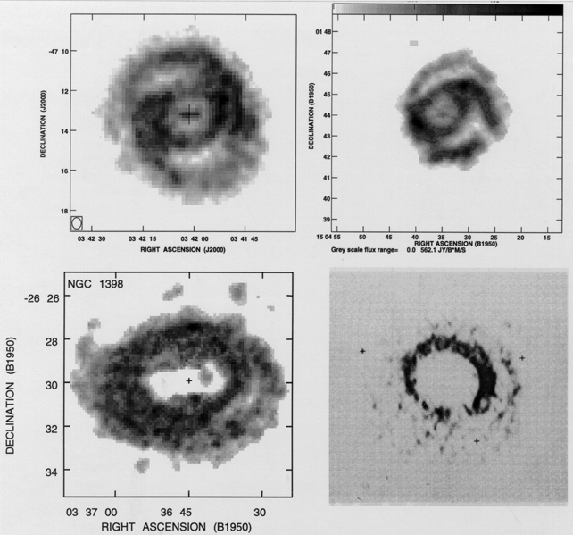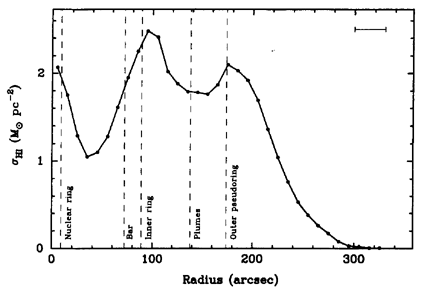



9.6. Neutral Hydrogen Emission from Ringed Galaxies
The distribution of HI has been mapped in several ringed galaxies. The first case so mapped was NGC 4736 by Bosma et al.(1977). These authors found that the distribution of HI mimics the optical appearance of the galaxy in blue light, showing concentrations of gas in the inner and outer rings and deficiencies of gas in the region inside the inner ring and in the ``gap'' between the two rings. The HI surface density reaches a maximum at the radius of the inner ring and a secondary maximum at the outer ring. Evidence for a probable noncircular shape for the inner ring was presented.
Mebold et al. (1979) did low-resolution HI mappings of two early-type outer-ringed galaxies, NGC 1291 and 1326. In each case, they determined that the kinematic line of nodes was nearly coincident with the major axis of the outer ring but not with the lens in the bar region. They suggested that the HI in both cases probably came from the outer rings, but could not resolve the exact location of the gas. This study suggested that NGC 1291 is inclined only 6° to the line of sight, which implied that the outer ring is intrinsically oval with an axis ratio of 0.9 and is aligned perpendicular to the bar.
Wevers (1984) carried out a detailed HI and optical study of 16 northern spiral galaxies. Several galaxies in his study show ring or pseudoring-like patterns in the HI distribution which are not attributable merely to HI ``holes''. For example, NGC 2903 shows a large outer HI pseudoring which has not been formally recognized in the galaxy's Hubble classification. The feature follows faint and extensive outer arms and produces a definite secondary maximum in the azimuthally-averaged surface density profile. The outer HI distribution Wevers found in NGC 4258 resembles the R'2 morphology, and deep optical images may verify this. The inner ring of the tidally disturbed ringed, barred spiral NGC 4725 (see Haynes 1979) is a clear, nearly closed enhancement of HI emission, coinciding also with the ring of HII regions found by Buta (1988).
Knapp et al. (1984) observed the HI distribution in NGC 7013, type (R')SA(r)0/a. They found an HI distribution well-described by two rings coincident with the optical observed ring patterns. The surface density of HI in the inner ring was found to be higher than that in the outer pseudoring.
Krumm et al. (1985) detected an outer HI ring in the SB0 galaxy NGC 4262. In this case, however, the outer ring has no optical counterpart and has a projected shape and velocity field suggesting that it is not coplanar with the main stellar disk. Krumm et al. suggest that the gas in this galaxy, which lies near the core of the Virgo Cluster, has probably been accreted as recently as 2 x 108 years ago. The accreted object could have been a gas-rich dwarf or an intergalactic HI cloud. Thus, the HI outer ring in NGC 4262 is not likely to be a resonance ring with the stellar bar in the main disk, but is probably related more to polar ring galaxies. In a similar vein, van Driel et al. (1988) detected inner and outer HI rings in the nonbarred S0 galaxy NGC 4203. The inner ring is nearly circular and may be connected to an HI hole, but the outer HI ring is a clear feature like that in NGC 4262 and may be due to accretion. More recently, Tilanus & Allen (1993) discovered what is probably also an accretion HI ring around the main body of the large spiral M83. These authors suggest that the HI ring and the large HI extent resulted from a past interaction with another galaxy.
Van Driel, Rots, and van Woerden (1988) obtained the HI distribution in two early-type galaxies with optical outer rings or pseudorings: NGC 1291 and NGC 5101. The observations of NGC 1291 are at much higher resolution than those obtained by Mebold et al. (1979), and reveal a maximum of HI surface density in the region of the outer ring and lower surface density gas beyond this region (see Figure 47). The region of the bar and inner lens was found to be devoid of any HI gas. In this same region, CBB found wispy filaments of ionized gas reminiscent of what is seen in M31, and Bregman et al. (1995) determined that the HI hole is also occupied by hot X-ray emitting gas. In NGC 5101, van Driel et al. also found a deficiency of HI gas in the bar/lens region. The maximum of HI surface density in this galaxy follows the R'2 part of an R1R'2 outer ring/pseudoring feature. A second partial HI ring not connected to optical structure was found outside this ring.

|
Van Driel & Buta (1991) presented HI observations of three very dissimilar pseudoringed galaxies: NGC 2273, 4826, and 6217. NGC 2273 is a rare example of a double outer-ringed galaxy where the two rings are well-separated (see Figure 22). The galaxy also has a bright inner pseudoring and bar. Van Driel and Buta found that the HI in this galaxy is largely associated with the outermost outer ring, with little or no gas in the innermost outer ring and the inner pseudoring. The maximum in azimuthally-averaged HI surface density is between the two outer rings. In NGC 6217, type (R'1)SB(rs)bc, the outer HI distribution does not follow the R'1, which is elongated perpendicular to the bar. Instead, it follows a ring-like distribution elongated along the bar, reminiscent of an R'2 outer pseudoring. Deeper images than available to van Driel and Buta may reveal this feature.
The R'1 outer ring of the unusual, ovally-distorted galaxy NGC 1808 is also a concentration of HI gas, as found by Koribalski et al. (1993). Unlike NGC 4736, however, the HI gas in the outer ring region has a rounder distribution than the optical ring and inner disk, prompting these authors to conclude that the outer HI disk is significantly warped. This interpretation is disputed by Bosma (1996).
Mulder (1995;
see also
Mulder & van Driel
1993)
has carried out a new
HI study of NGC 4736 with twice the resolution and better sensitivity
of the study by
Bosma et al. (1977).
At a resolution of 13" x 20", the inner ring of the
galaxy stands out as a clear enhancement of neutral gas and coincides
almost precisely with the inner optical ring of HII regions. The
azimuthally-averaged peak surface density in this ring is nearly
10M pc-2. The outer HI ring was found to be a more
complete feature than before, and coincides very closely with the
optical outer ring feature. Neutral gas was also found distributed
within the intermediate oval distortion zone.
pc-2. The outer HI ring was found to be a more
complete feature than before, and coincides very closely with the
optical outer ring feature. Neutral gas was also found distributed
within the intermediate oval distortion zone.
Moore & Gottesman (1995) carried out a study of the HI distribution in NGC 1398, an excellent example of Hubble type SB(rs)ab. The outer arms have been interpreted as type (R1R'2) in the CSRG, though the R1 component is very weak and the R'2 component does not close completely into a ring. The HI in NGC 1398 shows a strong central hole and little concentration of gas in the inner pseudoring zone (see lower left panel of Figure 47). Instead, the HI concentrates into an almost closed ring in the region of the outer arms, with more gas beyond.
Several other classic ringed barred spirals have recently been observed in HI: NGC 5850 by Higdon & Buta (1996) and NGC 1433 and 6300 by Ryder et al. (1996). The prototype SB(r)-type spiral NGC 1433 is interesting in that it has nuclear, inner, and outer rings/pseudorings and is the nearest example of the class. The HI distributions in NGC 1433 and 5850 are shown in Figure 47. In both cases, the HI distribution mimics the optical structure of the galaxy very closely. Both the inner and outer pseudorings of NGC 1433 are HI surface density enhancements as are the secondary arcs off the leading sides of the inner ring (compare with Figure 3). The bar region, and the areas between the inner and outer rings along the bar minor axis line, are deficient in HI. Ryder et al. suggest that these latter gas-deficient regions are connected to the L4 and L5 Lagrangian points near corotation with the bar pattern speed (see section 11.2).
Figure 48 shows the azimuthally-averaged HI
surface density
in NGC 1433, from
Ryder et al. (1996).
This shows that each optical
ring has an associated peak in HI surface density. The peaks are
around 2-2.5 M pc-2, and do not necessarily coincide
exactly with the ring radii.
pc-2, and do not necessarily coincide
exactly with the ring radii.

|
NGC 5850 is a ringed barred spiral which Hubble (1936) originally illustrated to define the SBb class of spirals. Like NGC 1433, the inner ring is a clear concentration of neutral gas (see upper right panel of Figure 47). The gas distribution in this case shows a significant asymmetry. The galaxy is a member of the NGC 5846 galaxy group (de Vaucouleurs 1975b; Turner & Gott 1976; Haynes & Giovanelli 1991), and may be suffering an interaction with another member of this group.
NGC 6300 is an SB(rs)-type spiral with no nuclear or outer ring. In contrast to NGC 1433, the HI distribution extends well-beyond the optical disk. Like NGC 1433, however, the inner pseudoring is a region of enhanced neutral gas concentration, although the density peak is broader than the extent of the optical ring feature. Ryder et al. (1996) suggest that the galaxy is in a transition phase and has not fully developed its outer resonance ring. Also unlike NGC 1433, NGC 6300 exhibits a loose tail of gas on its western edge and a 20° warp in the position angle of the line of nodes.
Several early-to-intermediate Hubble type barred galaxies show a central hole in the HI distribution. These cases have been interpreted by Koribalski (1996) as caused by HI absorption against strong nuclear continuum emission. The continuum emission is connected to nuclear rings of star formation, such as have been detected in NGC 7552 by Forbes et al. (1994a, b). Thus, Koribalski has suggested that HI holes trace the existence of nuclear rings in some galaxies.
Mundell et al. (1996) present interesting HI observations of the classic Seyfert galaxy NGC 4151. The large-scale HI distribution of this galaxy shows two main outer HI arms which roughly follow an R'2 morphology. HI delineates the fat oval which acts as the bar of the system. An HI hole includes a nuclear ring discovered by Vila-Vilaró et al. (1995).
In summary, HI observations of optically ringed galaxies show that rings are usually zones of increased HI gas surface density. Thus, the gas needed for fueling the active star formation in these features is definitely present, although not all of the clear ring or pseudoring features seen in these galaxies necessarily have detectable HI. Also, some galaxies show HI outer rings having no optical counterpart.